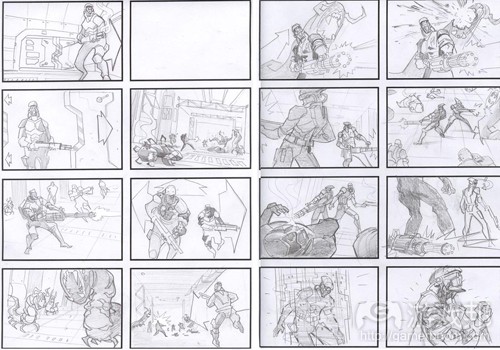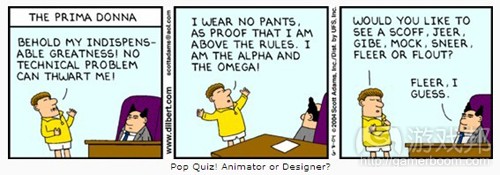设计师与动画师应化解矛盾共同开发游戏
作者:Tim Borrelli
设计师,你是否正与自认为设计比你更好的动画师合作?动画师,你是否正与丝毫不关心动画而只在乎游戏玩法的设计师合作?
最好停止争执,携手合作!
我之前的文章曾经阐述过动画和设计是相对立的。简单来说,从传统概念上来说,我觉得动画师不是设计师。我们为游戏的愿景服务,我们为设计和游戏玩法制作动画。的确,游戏开发团队中的每个人都会对游戏设计产生影响,但是这并不意味着人人都成为设计师。
但是,这也不能说明动画并非游戏设计的构成部分。
技术创造力
我们经常会讨论这个话题,就我而言,我还刚刚被Reanimators Podcast邀请前去做访谈。在播客中,我们讨论了在技术动画和整体动画方面,下一代的主机(游戏邦注:指PS4或Xbox 720等下一代主机设备)开发将如何发展。
诸如更现实化的服饰模拟、获得提升的皮肤和头发动态以及更好的身体姿态等话题都是需要注意的技术层面。当我们转向探讨动画时,动画师成为“运动设计师”的话题就出现了,因为动画网络编辑器使得动画设计更有技术含量。
10年之前,动画师或许就已经开始编写当时并非必需品的面部动画工具,现在他们理解的不只是基础逻辑,以及使用这些编辑器来探索动画之间如何相互配合。
在播客中,我提到之前自己做过预测,技术动画师将会被重新命名为“角色技术设计师”,技术动画扮演的不再只是包含动画和动画网络构建的角色。自那时起我一直都在考虑这个问题,而且我的预测有了很大的改变。
动作设计师
虽然许多工作室和动画师已经开始使用网络编辑器,我发现使用者间存在分裂性。有些地方有个技术动画师,全职负责创建网络,有些地方是动画师负责较为简单的东西,然后将较为复杂的内容交付程序员处理。而在某些地方,网络的设置甚至由设计师完成。
基于上述情况,在播客后我一直思考的问题是:业内是否有必要进行关于“运动设计师”的培训?
我曾经同那些认为应当有培训的动画师探讨过,他们认为此类培训应当有个以动画师为导向的工作流程。当问及原因时,大部分的回答是:因为设计师丝毫不关心动画的效果,他们只关注游戏的趣味性。这不是玩笑。
当然,设计师应当关注游戏玩法和游戏的趣味性,这是他们的本职工作!可这并不意味着他们不关心动画效果,即便他们确实如此,增加全新的培训也无法解决这个问题!设计师仍然会从自己的立场出发,转变动画网络的价值,使之更适合游戏玩法,而且他们也有贯彻自己想法的权利。
另一方面,需要知道如何在设计限制内设计动画恰恰是动画团队应当关注的事情。当设计部门要求加载动画在3秒内完成时,动画师要做的就是设计在3秒时间内呈现出最佳状态的动画。
动画师不希望看到在作品完成之后,设计部门将这部分时间缩短到2秒,因为这个时间与动画师的愿景间存在偏差。如果他们足够幸运的话,武器平衡工作人员会提醒他们提前做出相应修改,这样动画团队就可以在规定时间内进行更新,但是这种情况并不多见。
此外,设计师可能会要求英雄角色有着“粗暴和Clint Eastwood般的动作”,因此动画团队要关注的不仅仅是个体的姿态和动画时机,还需要关注角色动作的弯曲和转化方式。甚至是最微小的动画改变都可能影响到角色的形象。
那么,这是否意味着我们确实需要“动作设计师”培训?
我们需要,但是并非以某些人想象的方式开展。动作设计需要培训,但是此类培训已经存在。这不是个人化的角色,而是团队努力,结合了动画师和设计师双方的天赋和努力。不幸的是,双方都未曾注意到这种情况。这或许并非故意的,但双方的认知间总是存在偏差。
解决方法
并非所有的工作室都允许非设计师成员对游戏设计产生影响,但是这种情况并不需要恪守。动画和设计双方都可以做出努力来进行沟通。
设计师,你是否正与自认为设计比你更好的动画师合作?找到他们有这种想法的原因,然后同动画团队交流,弄清楚设计团队要怎么做才能够让动画团队明白他们所要做的是全力为项目愿景设计相符的动画。
但是,应当记住的是,你需要尊重动画师能够以游戏玩法为主来创造动画的能力。最好的情况是,你对动画有一定的理解和欣赏,这样你就不会只是拖动动画速度条来削减动画时间。
动画师,你是否正与丝毫不关心动画而只在乎游戏玩法的设计师合作?询问他们何种动画设计才能够最好地服务于游戏玩法,并且向他们提供外观和感觉都很不错的动画解决方案。
你也需要理解,游戏玩法是最重要的,你应当理解设计需要动画来辅助呈现游戏玩法。
结语
动画和设计之间往往会产生相互对立的目标,从而引发动作设计所有权的冲突。随着网络编辑器的到来和更多游戏对角色表现的关注,项目主导权已经成为了一个引发激烈争论的问题。
但是,游戏及其玩法应当能够决定用户所体验到的动作设计和角色表现。
依我看来,采用最棒的动作而且提供最具吸引力的游戏玩法所能采取的唯一最佳方法是将动画和设计工作结合起来,根本无需出现所谓的“动作设计师”这个职位。
因而我想再次强调的是:动画师需要理解设计师想法的来源,而设计师则需要理解动画师在创造你所要求的动作时所产生的激情。
总之,双方都不要再争执不休了,求同存异才是硬道理。游戏邦注:本文发稿于2011年11月14日,所涉时间、事件和数据均以此为准。(本文为游戏邦/gamerboom.com编译,拒绝任何不保留版权的转载,如需转载请联系:游戏邦)
Opinion: Who Designs Animation?
Tim Borrelli
Designers, do you work with animators or an animation lead who think they can design better than you with regards to animation? Animators, do you work with designers who don’t care how the animation looks as long as the gameplay feels right?
Well stop that and play nice!
My stance on animation vs. design has been documented before. Long story short, I feel that animators are not designers, not in the traditional sense. We serve the vision of the game, and we animate FOR design and gameplay. Yes, everyone who is part of a game development team has some amount of influence on game design, but that doesn’t make us all designers.
That doesn’t, however, mean that animation isn’t an integral part of design.
Technical Creativity?
This topic comes up in conversation frequently — in my case, when I was recently invited to be a guest on the Reanimators Podcast. During the podcast, we discussed where next-gen console development (the real next-gen, like PS4 and Xbox 720 or whatever) was headed in regards to tech animation and animation overall.
Topics like more realistic cloth sim, improved skin and hair dynamics, and better body physics were brought up as needing attention on the tech side. When we shifted to animation, the topic of animators being “motion designers” came up in regards to how more and more animators need to become technical in order to use animation network editors.
Where 10 years ago, animators may have begun to rig and write facial animation toolsets out of necessity (giving birth to the tech animation discipline), now they need to understand more than the basic logic that goes into how animations behave with one another to use these editors.
During the podcast, I believe I made the prediction that tech animators will be rebranded as Character TDs, and that tech animation will be more of an animation heavy role that involves animating AND building up these animation networks. I’ve thought about it since then and am changing my prediction a bit.
Motion Designers?
While many studios and animators have already been using network editors, I’ve noticed a split on who uses them. Some places have a tech animator setting up the networks full time, while some have the animators do the simpler blendtrees/state machines and pass them off to programming for the more complicated behaviors. And in some cases, even the designers set up the networks. In any case, there is still a back and forth between the owner of the animation networks and design.
With all of the potential hands in this pot, the question I’ve been thinking about since the podcast is this: Will the need arise for a “motion designer” discipline?
I’ve spoken with animators who think that the discipline should exist, and that it should have an animator-driven workflow. When pressed for reasons why, the typical answer has been “because designers don’t care about how the animation looks, they only care that it’s fast enough to be fun.” Well no kidding.
Of course designers care about gameplay and the game being fun — that’s what they do! That doesn’t mean they don’t care about how the animation looks, and even if they really don’t, creating an entire new discipline wouldn’t solve the problem! Designers will still want to get in there and tweak values in the animation networks to make it “feel” right for gameplay, and they have every right to want to do so.
On the other hand, it IS the animation team who knows how they intended their animation to look and feel within the design constraints. Where design may ask for a reload animation that is 3 seconds long, animators will create an animation with the timing INSIDE those 3 seconds that looks best.
They don’t want design going in and scaling the speed of the animation to 2 seconds, as the timing would then be off from the animator’s vision. If they are lucky, the weapon balancer will alert them to the change ahead of time so the animation team can get updates scheduled and executed (I’m fortunate to be in this situation), but this is not always the case.
Additionally, where design might want a hero character to have a “tough, Clint Eastwood-looking motion set,” the animation team will base that look on not only their individual poses and animation timings, but also how each of those motions blend and transition between each other. Tweaking even the slightest of blend values or cutting transitions out for the sake of a faster pace can break the immersion of the character being that “tough guy.”
So does that mean we absolutely need a “motion design” discipline?
Yes. But not in the way some might think. Motion design is a needed discipline, but it already exists. Instead of it being an individual role, however, it’s a team effort, combining the talents and hard work of animators AND designers. Unfortunately, the case can exist where each side (animation and design) doesn’t see it this way. It may not be intentional, but all too often there is a gap between the two disciplines when it comes to seeing eye to eye on looking good vs. feeling good.
How Can We Bridge The Gap?
Not all studio cultures allow anyone except designers to have influence on game design, but that doesn’t have to be the case. Both animation and design side can make the effort to bridge the gap between their disciplines, by working to resolve some of the following behavior patterns.
Designers, do you work with animators or an animation lead who think they can design better than you in regards to animation? Find out why they think that, and work with the team or the lead to figure out what the design team can do to get them what they need to animate effectively for the design vision.
Remember, however, that you need to respect the ability of the animators to create animation that will allow gameplay to come first. Ideally, you’ll have (or seek out) an understanding and appreciation for animation so you don’t just grab that animation speed slider and butcher the timing of animation.
Animators, do you have designers who don’t care how the animation looks as long as the gameplay feels right? Ask them what makes the gameplay feel right when they scale animation speed values, and offer them animation solutions that both look AND feel good.
You also NEED to understand that gameplay should come first, and you should build an understanding and appreciation of what design wants and needs a set of animations to do for gameplay.
The Answer
Animation and design are disciplines that often have desires that are at odds with each other, causing conflicts in determining the ownership of motion design. With the advent of network editors and a concentration on character performance in more and more games, the question of ownership has become a much bigger topic of debate.
However, the game and its gameplay should always determine what motion design and character performance the end user experiences.
The best, and in my opinion, only way to deliver the best motion possible while providing the most compelling gameplay is to have animation and design working together, without the need for an individual “motion designer” position the be created.
So I say again: Animators, make it a point to understand where the designers are coming from. Designers, make it a point to understand the passion that the animators have when creating the motions you request.
And both of you: Stop that and play nice! (Source: Gamasutra)









































 闽公网安备35020302001549号
闽公网安备35020302001549号